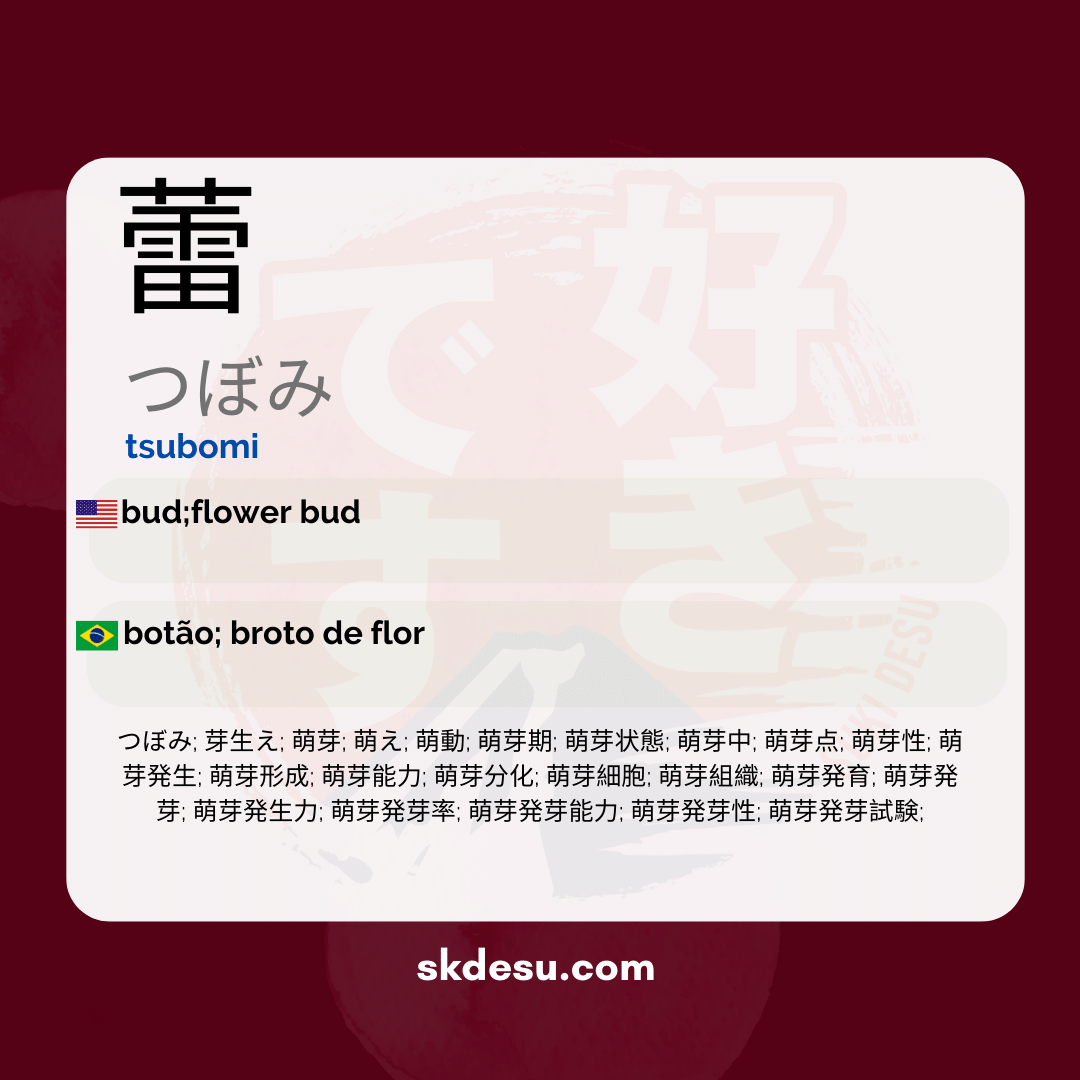Translation and Meaning of: 蕾 - tsubomi
The Japanese word 蕾[つぼみ] carries a poetic and delicate meaning, representing something that is about to bloom. In this article, we will explore its meaning, origin, and usage in everyday Japanese, along with cultural curiosities that involve this expression. If you are studying Japanese or simply interested in the language, understanding words like 蕾 can enrich your vocabulary and connection with Japanese culture.
In the Suki Nihongo dictionary, 蕾 is defined as "flower bud," but its meaning goes beyond the literal. It evokes the idea of potential, growth, and beauty that has not yet fully revealed itself. Let's see how this word is used in different contexts, from everyday conversations to references in Japanese media.
Meaning and origin of 蕾
The word 蕾 is written with a single kanji, but its reading in hiragana (つぼみ) is more common in everyday use. The character 蕾 is composed of the radical for "grass" (艹) combined with other elements that suggest something contained or closed. This visual construction reinforces the idea of a bud that has not yet opened.
Etymologically, つぼみ derives from the verb つぼむ, which means "to shrink" or "to contract." This linguistic origin perfectly reflects the concept of a flower that is still closed, preserving its beauty for the right moment. It is no wonder that this word frequently appears in Japanese poetry and songs, symbolizing hope and transformation.
Cultural use and frequency in Japanese
In Japan, 蕾 is not just a botanical term, but an important cultural metaphor. It appears in expressions like 蕾のまま散る (つぼみのままちる), which describes something beautiful that has vanished before blooming - a sad concept, yet valued in Japanese aesthetics. This idea is present in hanami, the tradition of appreciating cherry blossoms, where the buds are celebrated just as much as the open flowers.
In terms of frequency, つぼみ is a moderately used word in modern Japanese. It appears more in literary, poetic contexts or when one wants to emphasize the potential of something or someone. For example, calling a talented young woman 蕾 is a common compliment, suggesting that she will still grow and show all her potential.
Tips for memorizing and using 蕾
An effective way to memorize 蕾 is to associate its meaning with the visual of the kanji. Imagine the grass radical (艹) as leaves protecting a closed bud. This mental image helps to reinforce both the writing and the meaning of the word. Another tip is to remember that つぼみ sounds like something small and contained - the pronunciation itself seems "closed."
To practice the use of 蕾, try creating simple sentences like 桜の蕾が膨らんでいる (さくらのつぼみがふくらんでいる) - "The cherry blossom buds are swelling." Notice how this word appears in J-pop song lyrics or in anime dialogues about personal growth. Contextualizing learning always makes memorization easier.
Vocabulary
Expand your vocabulary with related words:
Synonyms and similar words
- つぼみ (tsubomi) - Flower button
- 芽生え (mebae) - Sprout; initial growth of a plant
- 萌芽 (moe) - Germination; the beginning of a plant's growth
- 萌芽期 (moeaki) - Germination period
- 萌芽状態 (moejoutai) - Germination state
- 萌芽中 (moejun) - In the germination phase
- 萌芽点 (moeaten) - Germination point
- 萌芽性 (moes性) - Germination capacity
- 萌芽発生 (moehassei) - Occurrence of germination
- 萌芽形成 (moekousei) - Budding formation
- 萌芽能力 (moenouryoku) - Capacity for sprout growth
- 萌芽分化 (moebunka) - Differentiation of shoots
- 萌芽細胞 (moesaibou) - Germination cell
- 萌芽組織 (moesoshiki) - Germination tissue
- 萌芽発育 (moeha育) - Growth during germination
- 萌芽発芽 (moehatsuga) - Germination of sprouts
- 萌芽発生力 (moehatsuseiryoku) - Germination force
- 萌芽発芽率 (moehatsugairitsu) - Germination rate
- 萌芽発芽能力 (moehatsuganouryoku) - Budding capacity
- 萌芽発芽性 (moehatsugasei) - Germination; condition of sprouting
- 萌芽発芽試験 (moehatsugashiken) - Germination test
Related words
Romaji: tsubomi
Kana: つぼみ
Type: noun
L: jlpt-n1
Translation / Meaning: button; flower sprout
Meaning in English: bud;flower bud
Definition: Flowers and tree buds.
Quick Access
- Vocabulary
- Writing
- Sentences
How to Write in Japanese - (蕾) tsubomi
See below a step-by-step guide on how to write the word by hand in Japanese. (蕾) tsubomi:
Example Sentences - (蕾) tsubomi
See below some example sentences:
Tsubomi wa utsukushii hana no hajimari desu
The flower starts with a beautiful bud.
Buds are the beginning of beautiful flowers.
- 蕾 - means "bud" in Japanese.
- は - Japanese grammatical particle that indicates the topic of the sentence.
- 美しい - Japanese adjective that means "pretty" or "beautiful".
- 花 - Japanese noun meaning "flower".
- の - Japanese grammatical particle indicating possession or relationship.
- 始まり - Japanese noun meaning "beginning" or "start".
- です - Japanese verb indicating "to be" or "to be" (polite form).
Other Words of this Type: noun
See other words from our dictionary that are also: noun

